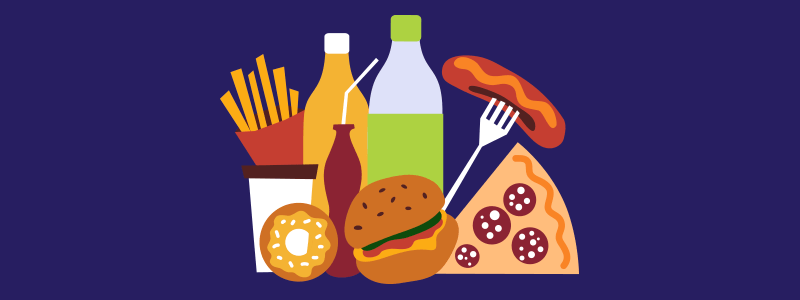Childhood obesity prevention is an important health topic, especially during the month of September, which is National Childhood Obesity Awareness Month.
Childhood obesity is a prevalent issue in the United States. It puts children at risk for poor health throughout life and can result in health conditions including:
- High blood pressure
- High cholesterol
- Type 2 diabetes
- Breathing problems (such as asthma and sleep apnea)
- Joint problems
Childhood obesity can also cause social and emotional issues. Kids and teens who are overweight are much more likely to be bullied, which can lead to mental health issues such as depression, isolation, and low self-esteem.
Read on to learn about childhood obesity statistics, causes, and preventative measures, including healthy food ideas for kids.
Childhood obesity statistics by age
Broken down by age groups, the percentages were as follows, indicating that the prevalence of childhood obesity increases with age:
- 2-5-year-olds: 12.7%
- 6-11-year-olds: 20.7%
- 12-19-year-olds: 22.2%
Childhood obesity statistics by population
Childhood obesity is also more common among specific populations. From 2017-2020 the statistics were as follows:
- 9% prevalence among non-Hispanic Asian children
- 16.6% prevalence among non-Hispanic White children
- 24.8% prevalence among non-Hispanic Black children
- 26.2% prevalence among Hispanic children

Childhood obesity causes
The primary causes of childhood obesity are lifestyle factors, such as an unhealthy diet and/or too little exercise. However, a number of other factors may come into play, including genetics, environment, other underlying health conditions, medications, stress, or lack of sleep. Socioeconomic status may also play a role since it can determine a child’s access to nutritious foods or their ability to exercise safely outdoors.
How to prevent childhood obesity
When it comes to obesity, studies show that prevention is better than cure. Taking steps to avoid childhood obesity early on prevents a lifelong struggle to try to overcome obesity as an adult. Creating healthy habits early in life can help your child maintain those habits later on. When working on these habits with your child, remember to keep a positive attitude and help them understand that a healthy lifestyle is a good thing, not something to avoid.
Keep in mind that even very young children can develop a negative body image or other self-esteem issues. Don’t shame your child, and don’t force them. The best way to create positivity around a healthy lifestyle is to model the behavior you wish to see in your child by embracing healthy habits in your own life.
There are many ways to be proactive in order to prevent childhood obesity, including increased physical activity, decreased sedentary activity, a healthy diet that includes fruits and vegetables, decreased sugar intake, and a healthy sleep schedule.

Physical Activity
Physical activity is one of the best ways to prevent childhood obesity, so ensure your child is getting enough exercise every day. Most experts recommend about 60 minutes per day. Take a bike ride with your child, or go for a walk. Make physical activity fun by visiting a park or playground, going roller skating, or having a dance party. Plan family vacations that involve exercise, such as camping, kayaking, hiking, or swimming. Even having your child do daily chores around the house can help get them moving more.
If your child prefers more social activity, sign them up for a team sport like soccer or baseball, a dance class, or martial arts training. Just like adults, kids have individual preferences, so try to find what works best for your child.
Less Sedentary Activity
Limiting screen time is important in order to get young children up and moving. Everyone needs a little downtime but set clear limits for how much time per day your child is allowed to be on screens, including TV, phone, computer, or other electronic devices. Suggest fun activities that your child can do when it’s time to put down the video game controller, like playing a game outside or taking the dog for a walk. Establishing exercise, rather than screen time, as a way to unwind at the end of a long day will set your child up for good health into adulthood.
Healthy Diet
A healthy diet can help your child establish a healthy weight early in life, which will pay off in the long run. It also provides the nutrients they need to grow and develop. Be sure your child is eating a healthy diet that is rich in fruits, vegetables, whole grains, lean proteins, and low-fat or fat-free dairy. For optimal health, make sure your child “eats the rainbow”: fill half of their plate with colorful fruits and vegetables at each meal.
Less Sugar
Sugar is one of the biggest culprits of childhood obesity. According to the CDC, children over age 2 should keep sugars to less than 10% of their daily calories, while children under 2 should have no added sugar in their diet at all. One great way to limit sugar intake is to avoid beverages such as sodas, juice drinks, and flavored milk, all of which are loaded with added sugar. It is also important to limit desserts like sugary baked goods, ice cream, and candy.
Sleep
Getting enough sleep can be very important in preventing childhood obesity. The CDC states that children 6-12 years old need 9-12 hours of uninterrupted sleep a night, while teenagers need 8-10. A lack of sleep may encourage your child to move less and eat more during the day. Establish a routine bedtime, and stick to it. This is especially important during the school year when most children will need to wake up relatively early each morning. Helping your child develop good sleep habits now will improve their long-term health and quality of life.

Healthy food ideas for the family
Eating fruits and vegetables may be a simple way to prevent childhood obesity, but how can you serve foods your child will actually enjoy? There are a number of healthy foods that are kid-friendly. Try some of these ideas for a healthy snack for your child:
- Yogurt
- Popcorn
- Nuts
- Cheese and crackers
- Frozen fruit popsicles
- Hard-boiled eggs
- Celery sticks with peanut butter
- Apple slices
- Carrots with hummus
- Olives
It may be best to start with foods your child is familiar with and slowly introduce new foods. You can even swap out some of your kid’s favorite snacks for similar but healthier options. At mealtimes, offer healthy options that you know your child enjoys. Or better yet, let them help prepare meals. Making cooking a family activity adds a social aspect to healthy eating that kids can enjoy and embrace.
We’re here for your family 24/7
With board-certified physicians, no wait, and 24-hour emergency care in your neighborhood, Neighbors Emergency Center is here for your family. Our centers even offer private pediatric rooms featuring animated characters to help set our youngest patients at ease. Our experienced emergency staff provides the highest quality emergency care for adults and children. Come to Neighbors for your family’s medical emergencies, and find out why we’re your best neighbors ever.
